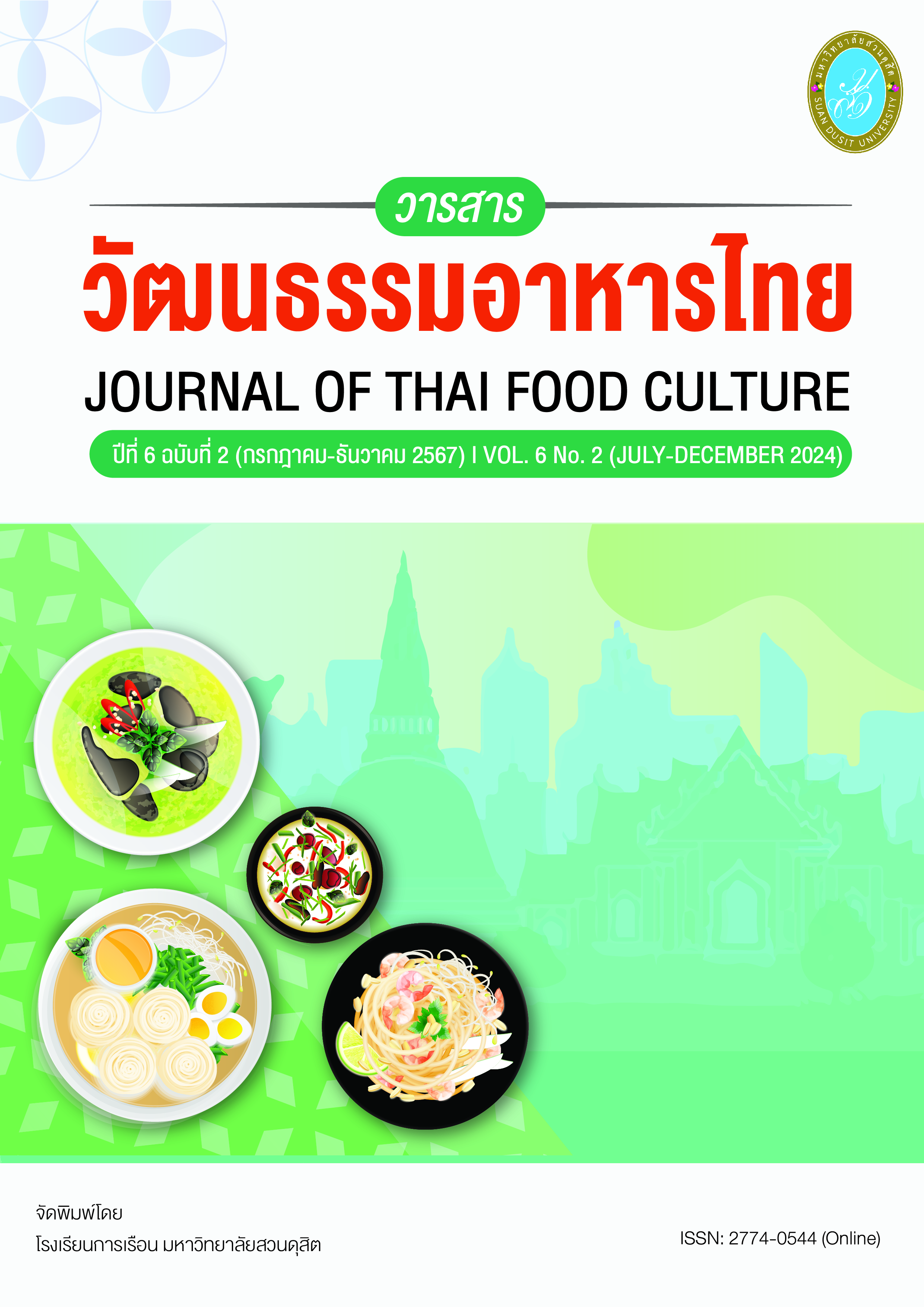Promoting gastronomic tourism through the storytelling of southern local food, a case study of: sour soup with seabass and young coconut shoots
Keywords:
gastronomy tourism, sustainable tourism, storytelling, social media, Kaeng Som Pla KraphongAbstract
Promoting gastronomic tourism through the storytelling of southern local food, a case study of sour soup with seabass and young coconut shoots. This article aims to study the local ingredients of Southern Thai food of the Kaeng Som Pla Kra Pong (sour soup with seabass fish) in Songkhla and to study how to cook the Kaeng Som Pla Kra Pong in Koh Yor, Songkhla. This study was an in-depth interview with the key informant in the locality of Banna sub-district, Chana district, Songkhla province, and data analysis by content analysis. As a result, a study of the local ingredients of southern Thai food of the Kaeng Som Pla Kra Pong in Koh Yor, Songkhla, found that there are 7 main local ingredients as details: 1) dried chili, 2) turmeric 3) garlic 4) salt 5) Shrimp paste 6) lemon juice and 7) seabass and use young coconut shoots. Process to cook the Kaeng Som Pla Kra Pong includes 4 steps: (1) preparing seabass (2) preparing the chili paste for yellow curry (3) cooking and (4) serving.
References
กลุ่มเศรษฐกิจการประมง กรมประมง. (2565). บทความปลากะพงขาวและผลิตภัณฑ์, กรมการค้าระหว่างประเทศ กระทรวงพาณิชย์. (ออนไลน์) เข้าถึงแหล่งข้อมูลได้จาก www.dtn.go.th สืบค้นเมื่อวันที่ 21 มิถุนายน 2566.
ธนวรรณ นาคินทร์. (2556). เมนูปักษ์ใต้ หรอยจังฮู้. กรุงเทพฯ: สำนักพิมพ์แสงแดด. (ออนไลน์) เข้าถึงแหล่งข้อมูลได้จาก https://clib.psu.ac.th/southernfood. สืบค้นเมื่อวันที่ 21 มิถุนายน 2566.
พรรณี สวนเพลง และคณะ. (2559). การท่องเที่ยวเชิงอาหาร (Gastronomy Tourism), รายงานภาวะเศรษฐกิจท่องเที่ยว, มหาวิทยาลัยสงขลานครินทร์ วิทยาเขตหาดใหญ่, เข้าถึงแหล่งข้อมูลได้จาก https//asean.psu.ac.th/Data/tourism/topic/17/Gastronomy_Tourism_TH2559.pdf?, หน้าที่ 1-4 สืบค้นเมื่อวันที่ 21 มิถุนายน 2566.
ศนิ สุวรรณศรี และคณะ.(2555). หนังปลากะพง, วารสารชุมชนศึกษา พลังชุมชน พลังเกาะยอ, (ออนไลน์) สืบค้นเมื่อวันที่ 21 มิถุนายน 2566.
Ballantyne, R., Hughes, K., Ding, P. and Liu, D. (2014), Chinese and international visitor perceptions of interpretation at Beijing built heritage sites, Journal of Sustainable Tourism, 22(5). 705-725.
De Vries, L., Gensler, S., & Leeflang, P. S. (2012). Popularity of brand posts on brand fan pages: An investigation of the effects of social media marketing. Journal of Interactive Marketing, 26(2), 83–91. https://doi.org/10.1016/j.intmar.2012.01.003
Dolan, R., Conduit, J., Fahy, J., & Goodman, S. (2017). Social media: communication strategies, engagement and future research directions. International Journal of Wine Business Research, 29(1), 2–19. https://doi.org/10.1108/ijwbr-04-2016-0013
Du Rand, G.E. and Health, E. (2006), Towards a framework for food tourism as an element destination marketing, Current Issues in Tourism, 9(3), 206-234.
Fons, M. V. S., Fierro, J. a. M., & Patiño, M. G. Y. (2010). Rural tourism: A sustainable alternative. Applied Energy, 88(2), 551–557. https://doi.org/10.1016/j.apenergy.2010.08.031
Gheorghe, G, Tudorache, P., & Nistoreanu, P. (2014). GASTRONOMIC TOURISM, A NEW TREND FOR CONTEMPORARY TOURISM?. Cactus Tourism Journal. 9. 12-21.
Hall, C.M. and R. Mitchell (2001), “Wine and food tourism”, in N. Douglas, N. Douglas and R. Derrett (eds.), Special Interest Tourism, John Wiley and Sons, Brisbane, 307-329.
Horvat, K. P., & Ribeiro, D. (2019). Izzivi v turističnem sektorju: kako se evropske turistične destinacije soočajo s preturizmom. Geografski Vestnik, 91(1). https://doi.org/10.3986/gv91104
Hansen, F., Kortbek, K. and Grønbæk, K. (2012), “Mobile urban drama”, New Review of Hypermedia and Multimedia, Vol. 18 Nos 1/2, pp. 63-89.
Lebowitz, J. and Klug, C. (2011), Interactive Storytelling for Video Games, Elsevier, Amsterdam.
Mathisen, L. (2013), “Staging natural environments”, Advances in Hospitality and Leisure, 9, 163-183.
Mora, D., Solano-Sánchez, M. Á., López-Guzmán, T., & Moral-Cuadra, S. (2021). Gastronomic experiences as a key element in the development of a tourist destination. International Journal of Gastronomy and Food Science, 25, 100405. https://doi.org/10.1016/j.ijgfs.2021.100405
Moscardo, G. (2017), “Stories as a tourist experience design tool”, in Fesenmaier, D. and Xiang, Z. (Eds), Design Science in Tourism, Springer International Publishing, Basel, 97-124.
Moscardo, G. (2018), “Tourist experience design”, in Cai, L. and Alaedini, P. (Eds), Quality Services and Experiences in Hospitality and Tourism, Emerald, Bingley, 93-108.
Nika Razpotnik Viskovic, Blaz Komac. (2021). Gastronoic Tourism: A Brief Introduction; Acta geographica Slovenica, 61-1, 2021, 95-105. [Online] Access online in June 21, 2023.
Skinner, H., Sarpong, D. and White, G. (2018), “Meeting the needs of the millennials and generation Z”, Journal of Tourism Futures, Vol. 4 No. 1, pp. 93-104.
Sinha, A. and Sharma, Y. (2009), “Urban design as a frame for site readings of heritage landscapes”, Journal of Urban Design, Vol. 14 No. 2, pp. 203-221.
Xu, F., Weber, J. and Buhalis, D. (2014), “Gamification in tourism”, in Xiang, Z. and Tussyadiah, I. (Eds), Information and Communication Technologies in Tourism 2014, Springer, Cham, pp. 525-537.
Yash Chawla, Grzegorz Chodak. (2021). Social Media Marketing for Business: Organic
Promotions of Web-Lings on Facebook; Journals of Business Research, Volume 135, October 2021, Pages 49-65. [Online] Access online in June 20, 2023.
Yeoman, I. and McMahon-Beattie, U. (2019), “The experience economy”, Journal of Tourism Futures, 114-119.
Zhang, L., & Pentina, I. (2012). Motivations and usage patterns of Weibo. Cyberpsychology, Behavior, and Social Networking, 15(6), 312–317. https://doi.org/10.1089/cyber.2011.0615
Downloads
Published
How to Cite
Issue
Section
License
Copyright (c) 2025 School of Culinary Arts, Suan Dusit University

This work is licensed under a Creative Commons Attribution-NonCommercial-NoDerivatives 4.0 International License.
ลิขสิทธิ์ต้นฉบับที่ได้รับการตีพิมพ์ในวารสารวัฒนธรรมอาหารไทย ถือเป็นกรรมสิทธิ์ของโรงเรียนการเรือน มหาวิทยาลัยสวนดุสิต ห้ามผู้ใดนำข้อความทั้งหมดหรือบางส่วนไปพิมพ์ซ้ำ เว้นแต่จะได้รับอนุญาตอย่างเป็นลายลักษณ์อักษรจากโรงเรียนการเรือน มหาวิทยาลัยสวนดุสิต นอกจากนี้ เนื้อหาที่ปรากฎในบทความเป็นความรับผิดชอบของผู้เขียน ทั้งนี้ไม่รวมความผิดพลาดอันเกิดจากเทคนิคการพิมพ์


